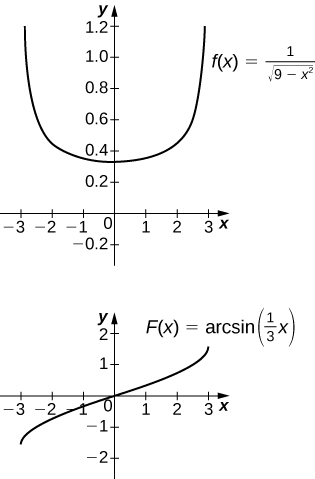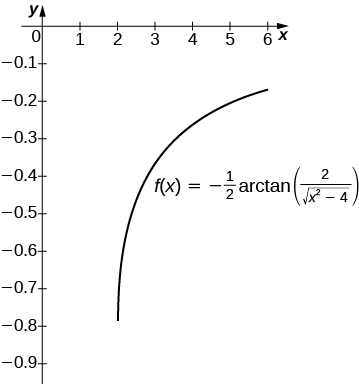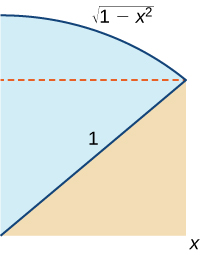- You do not have permission to view this page - please try signing in.
1.7E: Exercises for Section 1.7
- Last updated
- Sep 9, 2021
- Save as PDF
- Page ID
- 83602
( \newcommand{\kernel}{\mathrm{null}\,}\)
In exercises 1 - 6, evaluate each integral in terms of an inverse trigonometric function.
1) ∫√3/20dx√1−x2
- Answer
- ∫√3/20dx√1−x2=sin−1x|√3/20=π3
2) ∫1/2−1/2dx√1−x2
3) ∫1√3dx√1+x2
- Answer
- ∫1√3dx√1+x2=tan−1x|1√3=−π12
4) ∫√31√3dx1+x2
5) ∫√21dx|x|√x2−1
- Answer
- ∫√21dx|x|√x2−1=sec−1x|√21=π4
6) ∫2√31dx|x|√x2−1
In exercises 7 - 12, find each indefinite integral, using appropriate substitutions.
7) ∫dx√9−x2
- Answer
- ∫dx√9−x2=sin−1(x3)+C
8) ∫dx√1−16x2
9) ∫dx9+x2
- Answer
- ∫dx9+x2=13tan−1(x3)+C
10) ∫dx25+16x2
11) ∫dxx√x2−9
- Answer
- ∫dxx√x2−9=13sec−1(|x|3)+C
12) ∫dxx√4x2−16
13) Explain the relationship −cos−1t+C=∫dt√1−t2=sin−1t+C. Is it true, in general, that cos−1t=−sin−1t?
- Answer
- cos(π2−θ)=sinθ. So, sin−1t=π2−cos−1t. They differ by a constant.
14) Explain the relationship sec−1t+C=∫dt|t|√t2−1=−csc−1t+C. Is it true, in general, that sec−1t=−csc−1t?
15) Explain what is wrong with the following integral: ∫21dt√1−t2.
- Answer
- √1−t2 is not defined as a real number when t>1.
16) Explain what is wrong with the following integral: ∫1−1dt|t|√t2−1.
- Answer
- √t2−1 is not defined as a real number when −1<t<1, and the integrand is undefined when t=−1 or t=1.
In exercises 17 - 20, solve for the antiderivative of f with C=0, then use a calculator to graph f and the antiderivative over the given interval [a,b]. Identify a value of C such that adding C to the antiderivative recovers the definite integral F(x)=∫xaf(t)dt.
17) [T] ∫1√9−x2dx over [−3,3]
- Answer
-

The antiderivative is sin−1(x3)+C. Taking C=π2 recovers the definite integral.
18) [T] ∫99+x2dx over [−6,6]
19) [T] ∫cosx4+sin2xdx over [−6,6]
- Answer
-
![Two graphs. The first shows the function f(x) = cos(x) / (4 + sin(x)^2). It is an oscillating function over [-6, 6] with turning points at roughly (-3, -2.5), (0, .25), and (3, -2.5), where (0,.25) is a local max and the others are local mins. The second shows the function F(x) = .5 * arctan(.5*sin(x)), which also oscillates over [-6,6]. It has turning points at roughly (-4.5, .25), (-1.5, -.25), (1.5, .25), and (4.5, -.25).](https://math.libretexts.org/@api/deki/files/2641/CNX_Calc_Figure_05_07_203.jpeg?revision=1&size=bestfit&width=361&height=504)
The antiderivative is 12tan−1(sinx2)+C. Taking C=12tan−1(sin(6)2) recovers the definite integral.
20) [T] ∫ex1+e2xdx over [−6,6]
In exercises 21 - 26, compute the antiderivative using appropriate substitutions.
21) ∫sin−1t√1−t2dt
- Answer
- ∫sin−1tdt√1−t2=12(sin−1t)2+C
22) ∫dtsin−1t√1−t2
23) ∫tan−1(2t)1+4t2dt
- Answer
- ∫tan−1(2t)1+4t2dt=14(tan−1(2t))2+C
24) ∫ttan−1(t2)1+t4dt
25) ∫sec−1(t2)|t|√t2−4dt
- Answer
- ∫sec−1(t2)|t|√t2−4dt=14(sec−1(t2))2+C
26) ∫tsec−1(t2)t2√t4−1dt
In exercises 27 - 32, use a calculator to graph the antiderivative of f with C=0 over the given interval [a,b]. Approximate a value of C, if possible, such that adding C to the antiderivative gives the same value as the definite integral F(x)=∫xaf(t)dt.
27) [T] ∫1x√x2−4dx over [2,6]
- Answer
-

The antiderivative is 12sec−1(x2)+C. Taking C=0 recovers the definite integral over [2,6].
28) [T] ∫1(2x+2)√xdx over [0,6]
29) [T] ∫(sinx+xcosx)1+x2sin2xdx over [−6,6]
- Answer
-
![The graph of f(x) = arctan(x sin(x)) over [-6,6]. It has five turning points at roughly (-5, -1.5), (-2,1), (0,0), (2,1), and (5,-1.5).](https://math.libretexts.org/@api/deki/files/2643/CNX_Calc_Figure_05_07_207.jpeg?revision=1&size=bestfit&width=343&height=273)
The general antiderivative is tan−1(xsinx)+C. Taking C=−tan−1(6sin(6)) recovers the definite integral.
30) [T] ∫2e−2x√1−e−4xdx over [0,2]
31) [T] ∫1x+xln2x over [0,2]
- Answer
-
![A graph of the function f(x) = arctan(ln(x)) over (0, 2]. It is an increasing curve with x-intercept at (1,0).](https://math.libretexts.org/@api/deki/files/2644/CNX_Calc_Figure_05_07_209.jpeg?revision=1&size=bestfit&width=251&height=275)
The general antiderivative is tan−1(lnx)+C. Taking C=π2=lim recovers the definite integral.
32) [T] \displaystyle ∫\frac{\sin^{−1}x}{\sqrt{1−x^2}} over [−1,1]
In exercises 33 - 38, compute each integral using appropriate substitutions.
33) \displaystyle ∫\frac{e^t}{\sqrt{1−e^{2t}}}\,dt
- Answer
- \displaystyle ∫\frac{e^t}{\sqrt{1−e^{2t}}}\,dt \quad = \quad \sin^{−1}(e^t)+C
34) \displaystyle ∫\frac{e^t}{1+e^{2t}}\,dt
35) \displaystyle ∫\frac{dt}{t\sqrt{1−\ln^2t}}
- Answer
- \displaystyle ∫\frac{dt}{t\sqrt{1−\ln^2t}} \quad = \quad \sin^{−1}(\ln t)+C
36) \displaystyle ∫\frac{dt}{t(1+\ln^2t)}
37) \displaystyle ∫\frac{\cos^{−1}(2t)}{\sqrt{1−4t^2}}\,dt
- Answer
- \displaystyle ∫\frac{\cos^{−1}(2t)}{\sqrt{1−4t^2}}\,dt \quad = \quad −\frac{1}{2}(\cos^{−1}(2t))^2+C
38) \displaystyle ∫\frac{e^t\cos^{−1}(e^t)}{\sqrt{1−e^{2t}}}\,dt
In exercises 39 - 42, compute each definite integral.
39) \displaystyle ∫^{1/2}_0\frac{\tan(\sin^{−1}t)}{\sqrt{1−t^2}}\,dt
- Answer
- \displaystyle ∫^{1/2}_0\frac{\tan(\sin^{−1}t)}{\sqrt{1−t^2}}\,dt \quad = \quad \frac{1}{2}\ln\left(\frac{4}{3}\right)
40) \displaystyle ∫^{1/2}_{1/4}\frac{\tan(\cos^{−1}t)}{\sqrt{1−t^2}}\,dt
41) \displaystyle ∫^{1/2}_0\frac{\sin(\tan^{−1}t)}{1+t^2}\,dt
- Answer
- \displaystyle ∫^{1/2}_0\frac{\sin(\tan^{−1}t)}{1+t^2}\,dt \quad = \quad 1−\frac{2}{\sqrt{5}}
42) \displaystyle ∫^{1/2}_0\frac{\cos(\tan^{−1}t)}{1+t^2}\,dt
43) For A>0, compute \displaystyle I(A)=∫^{A}_{−A}\frac{dt}{1+t^2} and evaluate \displaystyle \lim_{a→∞}I(A), the area under the graph of \dfrac{1}{1+t^2} on [−∞,∞].
- Answer
- 2\tan^{−1}(A)→π as A→∞
44) For 1<B<∞, compute \displaystyle I(B)=∫^B_1\frac{dt}{t\sqrt{t^2−1}} and evaluate \displaystyle \lim_{B→∞}I(B), the area under the graph of \frac{1}{t\sqrt{t^2−1}} over [1,∞).
45) Use the substitution u=\sqrt{2}\cot x and the identity 1+\cot^2x=\csc^2x to evaluate \displaystyle ∫\frac{dx}{1+\cos^2x}. (Hint: Multiply the top and bottom of the integrand by \csc^2x.)
- Answer
- Using the hint, one has \displaystyle ∫\frac{\csc^2x}{\csc^2x+\cot^2x}\,dx=∫\frac{\csc^2x}{1+2\cot^2x}\,dx. Set u=\sqrt{2}\cot x. Then, du=−\sqrt{2}\csc^2x and the integral is \displaystyle −\tfrac{1}{\sqrt{2}}∫\frac{du}{1+u^2}=−\tfrac{\sqrt{2}}{2}\tan^{−1}u+C=\tfrac{\sqrt{2}}{2}\tan^{−1}(\sqrt{2}\cot x)+C. If one uses the identity \tan^{−1}s+\tan^{−1}(\frac{1}{s})=\frac{π}{2}, then this can also be written \tfrac{\sqrt{2}}{2}\tan^{−1}(\frac{\tan x}{\sqrt{2}})+C.
46) [T] Approximate the points at which the graphs of f(x)=2x^2−1 and g(x)=(1+4x^2)^{−3/2} intersect, and approximate the area between their graphs accurate to three decimal places.
47) [T] Approximate the points at which the graphs of f(x)=x^2−1 and f(x)=x^2−1 intersect, and approximate the area between their graphs accurate to three decimal places.
- Answer
- x≈±1.13525. The left endpoint estimate with N=100 is 2.796 and these decimals persist for N=500.
48) Use the following graph to prove that \displaystyle ∫^x_0\sqrt{1−t^2}\,dt=\frac{1}{2}x\sqrt{1−x^2}+\frac{1}{2}\sin^{−1}x.


